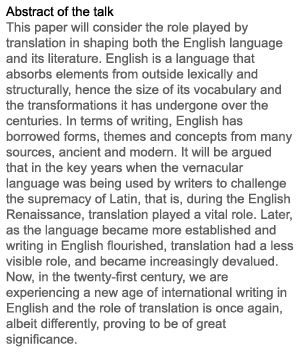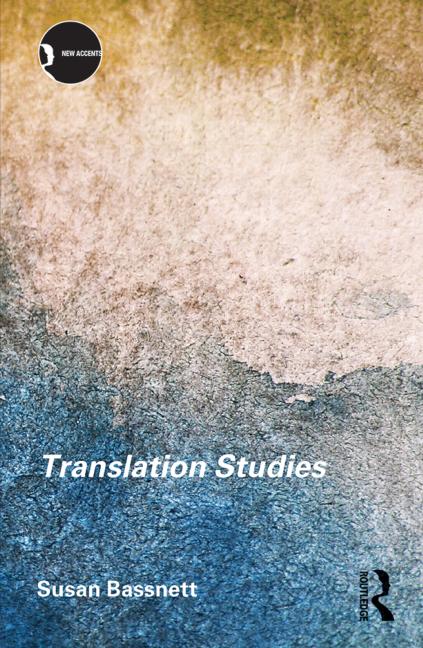September 16, 2013
Special SWET Report: Susan Bassnett on Translation as a Shaping Force in English
Juliet Winters Carpenter
This article is a summary of a talk given by Professor Susan Bassnett of the University of Warwick, at the plenary session of the annual conference of the Japan Association of College English Teachers, with support from the British Council, held at Kyoto University, Clock Tower Hall, 31 August 2013. Professor Bassnett is author of Translation Studies (4th edition; London & New York: Routledge, 2013), Translation (Routledge New Critical Idiom series: 2013), The Translator as Writer ed. Susan Bassnett and Peter Bush (London and New York: Continuum, 2006), and Reflections on Translation (Clevedon: Multilingual Matters, 2011).
 Professor Bassnett began by taking us on an imaginary journey around Britain, to take note of its enormous variety of place names, many of them recurring. Stratford-on-Avon, for example, is but one of many Stratfords. The Anglo-Saxon word “Stratford” means “ford on a Roman road.” Many British place names contain topographical elements: Oxford, a place where oxen ford; Cambridge, bridge on the river Cam. Many river names are Celtic in origin; Avon itself means “river,” so the River Avon is literally the “River River.” Place names ending in “by” (Whitby, Selby) are Danish in origin, from the Norse “byr” meaning farm or settlement; those ending in “chester” (Winchester, Dorchester) are Roman. The Oxford Dictionary of Place Names is a good companion on such trips. Farther north, we encounter the element “thwaite,” meaning a sloping valley. We can see that from north to south, place names are Norse, Danish, Saxon, Roman, British, and also Norman, as in “Richmond.” The meager data of recorded history is thus supplemented by place names.
Professor Bassnett began by taking us on an imaginary journey around Britain, to take note of its enormous variety of place names, many of them recurring. Stratford-on-Avon, for example, is but one of many Stratfords. The Anglo-Saxon word “Stratford” means “ford on a Roman road.” Many British place names contain topographical elements: Oxford, a place where oxen ford; Cambridge, bridge on the river Cam. Many river names are Celtic in origin; Avon itself means “river,” so the River Avon is literally the “River River.” Place names ending in “by” (Whitby, Selby) are Danish in origin, from the Norse “byr” meaning farm or settlement; those ending in “chester” (Winchester, Dorchester) are Roman. The Oxford Dictionary of Place Names is a good companion on such trips. Farther north, we encounter the element “thwaite,” meaning a sloping valley. We can see that from north to south, place names are Norse, Danish, Saxon, Roman, British, and also Norman, as in “Richmond.” The meager data of recorded history is thus supplemented by place names.
The hybridity of English language, culture, and literature shows layers of interconnectedness between diverse people often originally hostile to one another. The language has undergone continual change; words can never be fixed, pinned down. As Dr. Johnson noted in the Preface to his dictionary, “Words are hourly shifting their relations, and can no more be ascertained in a dictionary, than a grove, in the agitation of a storm, can be accurately delineated from its picture in the water.” The flexibility of English, its willingness to embrace words from diverse languages, has contributed to the great richness of its vocabulary: 42,000 words in Dr. Johnson’s Dictionary, some 450,000 today. As an example of current new usages, British teens say something is “bare deep,” meaning “too difficult.” This is why translations date fast—theater dialogue especially.

As an example of how words change, Professor Bassnett examined the word “surf.” She said she is what’s known as a “silver surfer,” someone who despite their advanced age dares to surf the Internet. Curious about the word “surf,” she looked it up and found it is a bit of a mystery. Earliest mention comes from a captain’s log on the Indian Ocean in the 16th century, where he describes the “surf” of the waves. She believes this was an auditory image, related to the English “sough.” Listening for waves was essential for navigators. Over the centuries the word became accepted in another sense, as the breaking of waves, then as the sport involving waves, and finally in its metaphorical usage today.
Translation, and comparative literature, can be seen as a process of tracing patterns. It is undesirable to isolate language and culture. Matthew Arnold said, “Everywhere there is connection, everywhere there is illustration. No single event, no single literature is adequately comprehended save in relation to other events, to other literatures.”
National literature is a nineteenth/twentieth-century concept. Its monolingualization is problematic. Translation is sometimes seen as a source of contamination, something with the status of an illegal immigrant. And yet it was absolutely fundamental to the development of English literature. One hundred years ago, English literature ranked below the classics. An anthology in 1918 declared, “English literature always ought to obey the teachings of its mother, Greek.” The date is significant, coming just after World War I. In other words, the compiler wished to stress that English literature was not Germanic in origin, but derived from a more ancient source. And yet the first professorship of English was not in England but in Germany, at the University of Gottingen in 1762, held by one John Thompson (no one knows much else about him).
In 1941 (again politically significant, just at the start of World War II), George Sansom edited the Cambridge Concise History of English Literature. He was determined to show that English literature owes nothing to anyone. He lists Chaucer as the “first English author”, yet a contemporary of Chaucer describes him not as an author but as a “great translator.” He worked with Middle English, French, Anglo-French, and Latin. Sometimes he did straightforward translations, sometimes he incorporated translations into his own work, sometimes he says something is a translation when it isn’t. In other words, Chaucer plays with the notion of authority, the idea of the “original.” He is known as the father of English literature, but we must note that he made full use of his multilingual environment and drew from multiple sources.

Sansom wrote that nothing much happened from Chaucer to Shakespeare—a common misconception. In fact, that interim was a rich time of translation spanning two centuries. As one example, we can trace the development of the sonnet through translation. Texts change through the process of translation; a later text’s structure, objective (why it was written), readers, and rhythm are all necessarily different from the original. In Italian, the sonnet as represented by Petrarch was fourteen lines in an 8/6 pattern. In English, in the hands of someone like Wyatt, this became a 4/4/4/2 pattern. Philip Sidney’s sonnet on the process of writing shows how this new pattern took English literature itself in a new direction, as the final two lines became a summing up of the whole poem, and more: the final couplet was used to turn around the original rhetoric and give it an ironic twist. Here are Sidney’s last three lines, after the poet has agonized over his inability to write to his lady so that she may return his ardent love:
Thus, great with child to speak, and helpless in my throes,
Biting my truant pen, beating myself for spite,
Fool, said my muse to me, look in thy heart and write.
This ironic “turn-around” ending has become an English convention often seen today in journalism, for example. A newspaper column or an editorial, for example, may begin with one statement and then go on through a line of argument to conclude the opposite. Other languages with different rhetorical traditions can’t do this.

English is inclusive, and translation has been a source of many interesting innovations. The magic realism of Latin American literature in translation is reflected in the writings of Salman Rushdie. Poe invented the detective novel, himself influenced by Voltaire; Agatha Christie became a leading writer of detective novels, and now through translation we see Scandinavian writers further developing the genre. Reading patterns and tastes change through translation as well.
A major question is this: What gets or doesn’t get translated? Somewhat surprisingly, Dante’s epic poem The Divine Comedy dating from the thirteenth century, was not translated into English until the nineteenth century, when Henry Francis Cary first rendered it into English. Another Dante translator, the American poet Henry Wadsworth Longfellow is honored with a plaque in Florence, inscribed to “the master of the new Latin, the great American translator” (not poet!). Later, T. S. Eliot’s The Wasteland and much of the work of Seamus Heaney would be influenced by Dante—thanks to the availability of The Divine Comedy in translation.
Literature, in short, is porous.
To show how worlds coincide through literature and translation, Professor Bassnett closed by inviting us on another imaginary tour. She suggested we go online to follow “The Road North,” a travel blog by two poets through Scotland, with a “word map” where you click on a link to read their comments. The idea for the journey is based on Bashō’s Oku no hosomichi (trans, Narrow Road to the Deep North). The poets intentionally began their journey in 2010 on March 6—the same date Basho began his in 1689. They claim Bashō as their guide, using a 1955 translation of his work published by Penguin, and sharing their vision with readers around the world through twenty-first-century technology. Did Bashō even know Scotland existed? Probably not, but surely he would be happy about this development.
Q&A

In response to a question on how to test translation, Professor Bassnett mentioned the Stephen Spender/Times poetry translation prize of which she has been a judge for years. Participants are judged not just on their translation, but on their commentary about the translation. Translation students should be encouraged to be self-reflective. But there is a problem in discussing the issue, since pedagogical uses of translation need to ascertain a certain basic understanding, while literary translation has different aims altogether. These different concepts exist simultaneously, so there is no easy answer.
Someone else asked about technical translation, and Professor Bassnett opined that technical translators actually have more freedom since, different to a literary text, there is an objective beyond the text. The technical translator must decode and recode within the framework of the expectations of the target language; failure to do so would result in a laughably unreadable text. This freedom ought to apply to literary translation as well.
In response to a question about changing styles of translation today, she noted that “translation is rewriting” and that the translator must recapture, rethink the original. The greatest thing a translation can do is open a door; to judge translations solely in terms of their accuracy or inaccuracy is misleading.
Originally published on the SWET website with permission from Dr. Susan Bassnett, September 11, 2013; slightly edited © 2013 by Juliet Winters Carpenter/SWET.
